I was looking for a watch with barometric function for weather predictability given my outdoor activities and chanced upon the G-Shock Riseman GW-9200. This baby was charged by solar (like my Citizen EcoZilla), had barometer, altimeter, temperature reading, world time, alarms, stopwatch, yada yada yada. Everything but the kitchen sink has been packed into this tough watch; and in a sense, the watch would probably be much like the Swiss army knife of the timepiece world.
I was pretty amazed with this watch and started researching further on the subject. Apparently, there were 2 models for the Riseman ie GW-9200 and GW-9200J. The former was manufactured in Thailand and the latter manufactured in Japan, or so you would have deduced. Apparently, the GW-9200J was manufactured in both Thailand and Japan, with the one really from Japan and for the Japan domestic market commanding a higher price and highly-sought after by G-Shock collectors.
Confused yet?
 |
| Both these Risemen were made in Casio's Thailand manufacturing plant... |
 |
| While this piece was truly manufactured in Casio's Japan plant for JDM. |
The hunting then started. Not many shops carry this model so I had to hunt and ask around a bit. But it all paid off when I managed to source for both the Thailand-made and Japan-made Risemen with one becoming my hard-wearing, terrain-conquering sweat piece; and the other cocooned safely in the safety of my watch cabinet.
An advert that I found on Mudah on the real deal. Most of the rest of the Risemen were non-airwave interceptor units :
I shall utilise the review from Andy of Gadgeteer as per the following :
I’m the kind of person who can only wear one watch at a time. That is, I don’t wear one to work, another one for play, and yet another for dress. So it’s important to me that whatever I wear does everything I need.
Unfortunately for me, I’m drawn to gadgets, and I can be hard on my toys. For this reason, I’m a big fan of the Casio G-Shock products. Today I’m writing about my latest purchase, the Casio G-Shock GW9200-1 “Riseman” watch.

The GW9200-1 Riseman comes in a nice, cylindrical tin box. There are way too many features to list individually, so here are the main ones:
- Multi-Band Atomic Timekeeping (US, UK, Germany, Japan, China)
- Tough Solar Power
- 200M Water Resistant
- Altimeter
- Barometer
- Thermometer
- World Time
- 5 Daily Alarms (1 with snooze)
- Countdown Timer (1 minute to 24 hours)
- 1/100 second stopwatch (24 hours)
- Measuring modes: Elapsed time, split time, 1st-2nd place times
- Hourly Time Signal
- Approx. battery life: 9 months on full charge (without further exposure to light)
- Size of case/total weight: 51 x 48.9 x 15.9mm / 60.9g
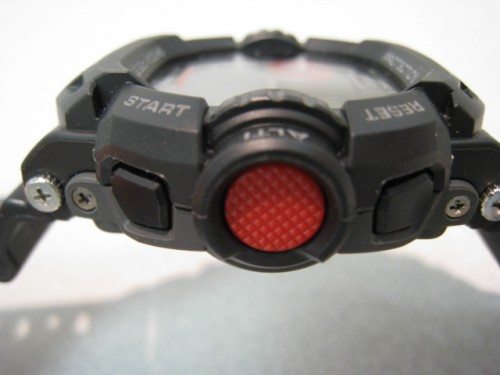
Note how the glass face is recessed around the G-Shock's trademark "armor".
There are other Casio “ABC” watches (Altimeter, Barometer, Compass), namely the Pathfinder/Protrek series, but the Riseman does not have a compass. What you gain, however, is a watch that is more in line with the G-Shock styling with the protected, recessed mineral crystal glass, and the plastic resin body that hides minor wear marks quite well.
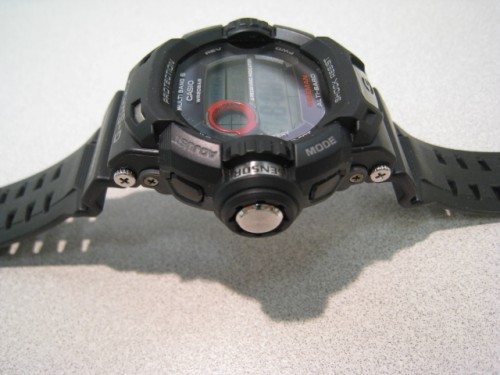
The round, silvery thing on the side is the sensor.
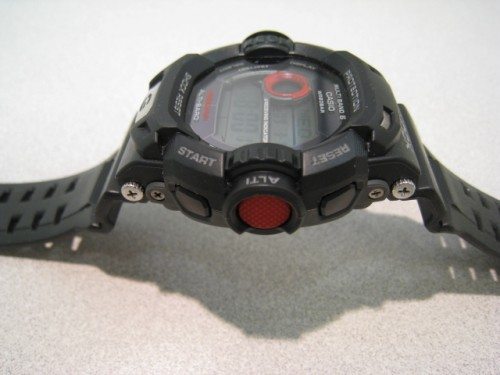
The red button activates the altimeter mode.
At first glance, the Riseman has a funny lump on the left side, which houses the sensor for the altimeter, barometer and thermometer. (Edit: There is only one sensor placed in the “lump” and that is a barometric pressure sensor. The watch then has a US Standard Atmosphere 1976 barometric formula based standard conversion chart in its memory that enables the watch to derive altitude readings from the current barometric pressure readings. Thanks to Watchuseek Forum member Joakim Agren for the correction.)
Unlike most Casio G-Shocks, the Riseman is controlled with six buttons instead of the usual five. Where’s the sixth button? The big red one on the right labeled “ALTI”. More on individual functions later.
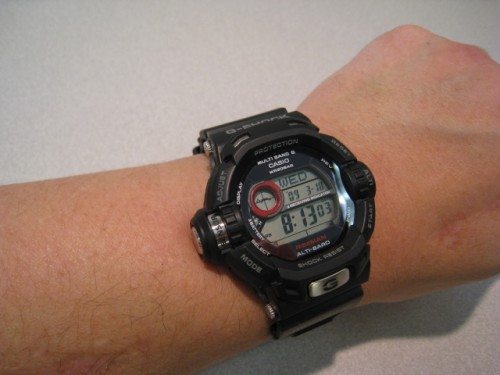
Riseman on my 7-inch wrist.
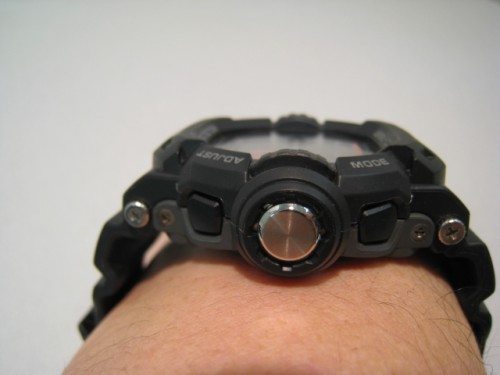
Looking at watch on wrist from the left.
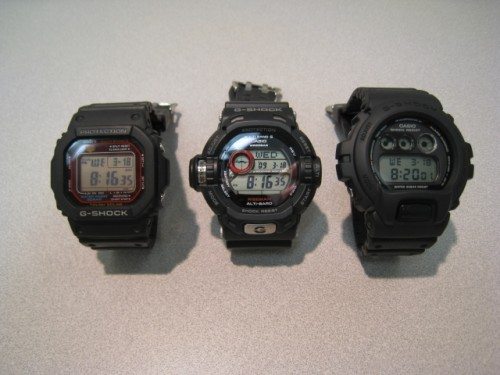
Family portrait! (Left to right): Casio 5600 series, Riseman, Casio 6900 series.
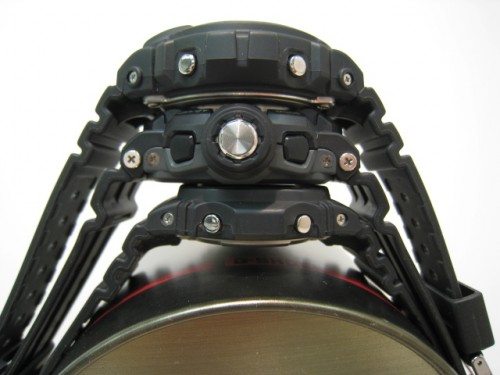
Stack 'em up! 6900 (top), Riseman (middle) and 5600 (bottom)
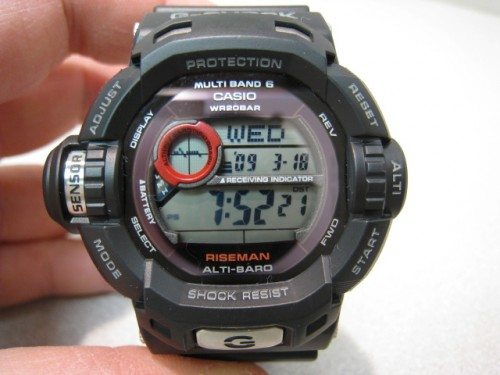
The Riseman’s face is split into several sections. The bottom digits display the time. The middle portion shows the year and month/date. The top section shows the day of the week. The red circle shows the barometric trend for the last 24 hours in two hour intervals per dot. Increasing pressure generally means improving weather, and decreasing pressure equates to degrading weather. Your results will vary!
The solar panels that charge the battery surround the LCD display. Current battery level is displayed via tiny LCD segments for L, M and H (Low, Medium, High). To save power, the Riseman has a user-selectable feature that turns the LCD off after a preset interval of no light, such as when you turn the lights out to sleep. This power saving feature can be also be activated if you wear long sleeves covering the watch long enough. I’ve never found this to be an issue as the watch comes back to life quickly.
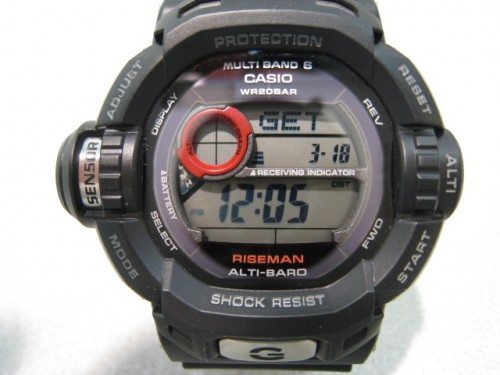
Screen shows the last sync'd time.
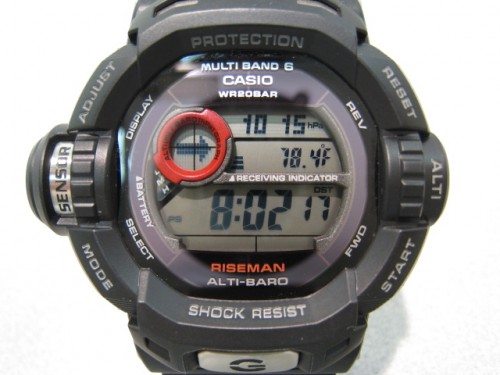
Pressing the MODE button cycles through the various watch modes. The first one is the barometer. In this mode, the current barometric pressure is displayed on the first row in either hPa or inHg, depending if you prefer metric or imperial units. The second row displays current temperature (C or F), and the red circle displays the recent barometric trend, user selectable as the 24-hour dot matrix graph or an easy to read arrow. What’s nice is that the Riseman constantly displays the current time at the bottom line. One problem is that as you wear the watch, the temperature displayed is most likely skewed due to heat from your wrist. Taking off the watch for a few minutes assumes a more accurate room temperature.
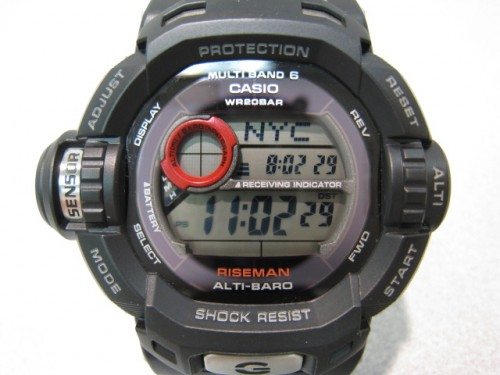
The next mode is the world time display. The city code shows on the top line (LAX, NYC, etc.) and the bottom row shows the time in that time zone. The middle row shows your local, current time for reference.
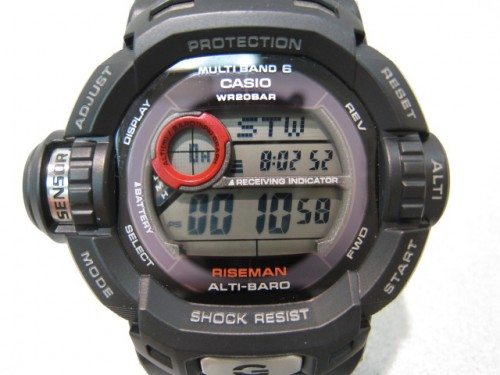
Pressing the mode button again gets you to the stopwatch. Pressing the START button starts and stops the stopwatch. The RESET button (upper right) clears to zero. You may notice the red circle shows the elapsed number of hours. The Riseman is rare in that it’s one of the few Casio G-Shocks to measure up to 24 hours, as well as displaying the current time in the middle display. This feature is more rare than you’d think.
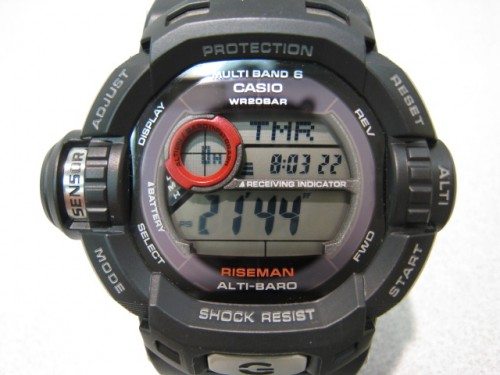
The next mode is the countdown timer. You start and stop the timer much like the stopwatch. The countdown timer can be set for a maximum of 24 hours and also displays the current time in the middle display. When the time reaches zero, the Riseman beeps.
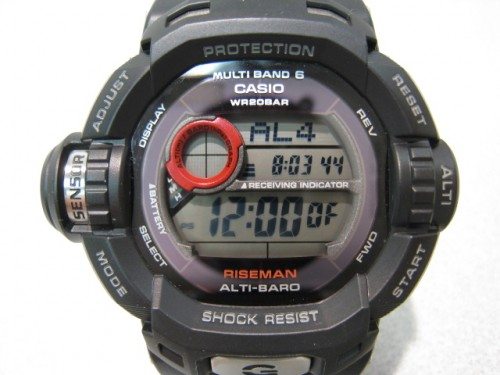
The alarm is the next mode. There are four individual alarms you can set, and one individual alarm you can set with a built-in snooze feature. In a break with Casio standards, pressing the big red ALTI button toggles each alarm on or off. If you’re familiar with G-Shocks and don’t read the manual to the Riseman, you’ll get confused at first as I did!
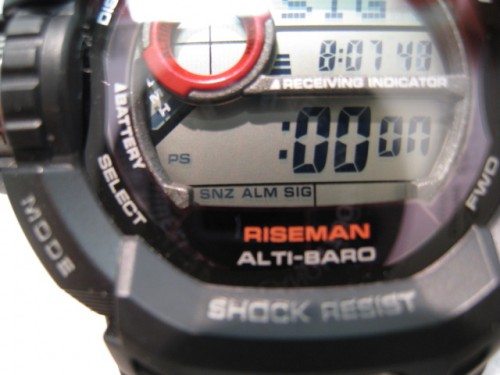
Small three-letter abbreviations appear on the bottom row to indicate Snooze (SNZ), Alarm (ALM) and hourly signal chime (SIG).
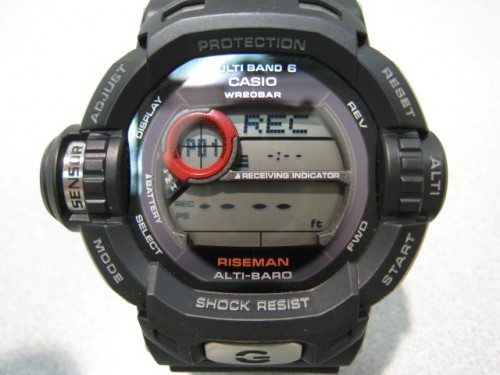
The last mode serves as an altimeter high/low playback. It shows the “min” and “max” recorded altitudes with the time stamp.
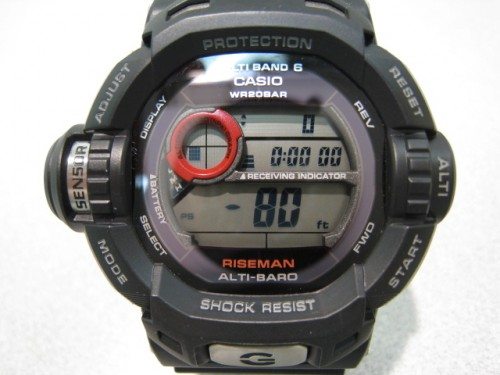
Speaking of altitude, the digital altimeter can be accessed in the timekeeping mode by pressing the red ALTI button. I have not calibrated this watch yet so it shows my altitude as a negative. A quick elevator ride proved to me that the altitude does change as expected.
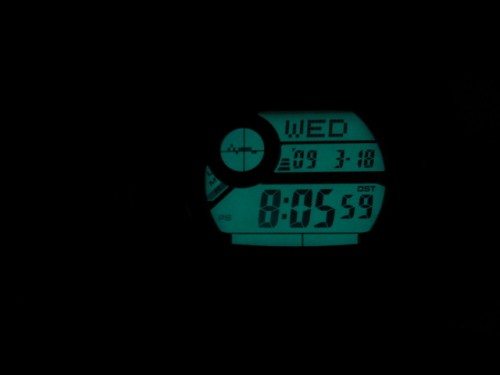
No do-it-all watch would be complete without a backlight! Pressing the big “G” button brings up an electroluminescent backlight. This can also be programmed to turn on with a flick of the wrist.
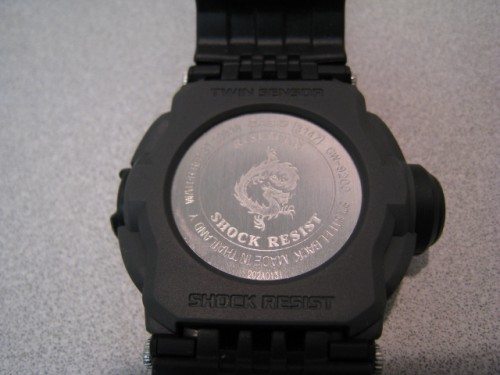
The back of the watch is no slouch, either. It’s surrounded by a plastic trim piece that must be removed to access the battery hatch. Notice the dragon pattern on the back. If you have a “flying squirrel” on the back instead of a dragon, you’ve got a version originally slated for sale outside the United States.
Edit: The Flying Fire dragon case back is found not only on US models but on all International atomic versions and on all non atomic version. The Flying squirrel is exclusive to Japanese domestic markets models and only found on the atomic versions. The Japanese versions do not support metric and imperial conversions for the different measurements given by the sensors, they are strictly metric only. (Thanks to Watchuseek Forum member Joakim Agren for the correction.)
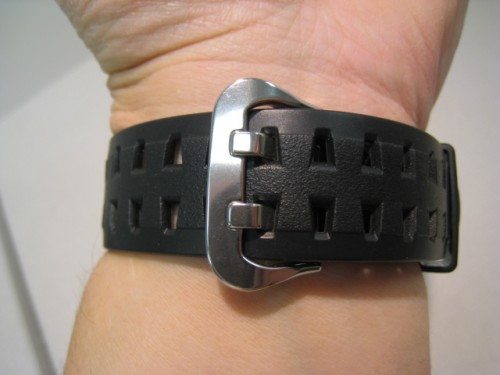
The strap is made of the same durable resin type material as the watch case. A dual-hole buckle gives it a real tough look.
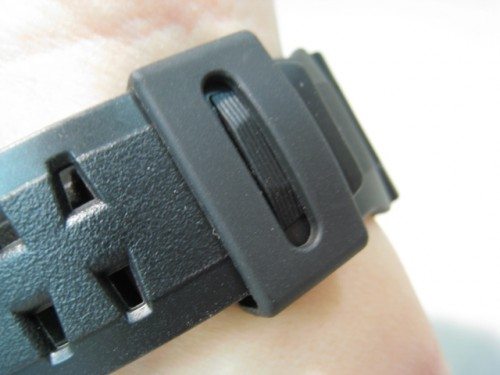
I like how the tip of the strap has a small bump at the end that helps the keeper from sliding off.
Do I like the Riseman? Oh yes I do! In fact, it’s the only watch I wear, and it does everything I need it to do.





This comment has been removed by a blog administrator.
ReplyDeleteWhat's up, all is going perfectly here and ofcourse every one is sharing information, that's actually good, keep
ReplyDeleteup writing.